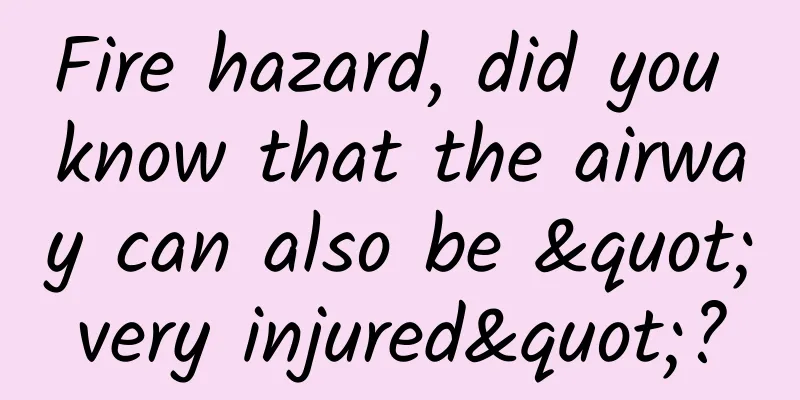Fire hazard, did you know that the airway can also be "very injured"?

|
This is the 4864th article of Da Yi Xiao Hu In recent news, there have been many cases of fires caused by negligence in the kitchen, or electric vehicles illegally charging in the corridor, causing fires, and even deflagrations and explosions. We all know that fires and explosions will produce a large amount of high-temperature, toxic and harmful smoke, which can easily cause respiratory damage or even suffocation to trapped people, seriously threatening people's lives. In fact, many places or places in life are under the shadow of flammable and explosive materials. We need to learn to protect ourselves, especially our delicate respiratory tract. After a fire occurs, thick smoke will be produced. The characteristics of hot smoke will rise upwards, and a large amount of thick smoke will float on the upper floors, which will cause harm to people on the upper floors. Experts remind that you should never try to get out of fireworks. It is recommended to lower your body in the thick smoke, preferably crawling, and keep your head as close to the ground as possible, for example, keep it below 30 cm. If there is a sudden explosion, it is often accompanied by flames shooting into the sky, and the energy of the explosion is released, and there is a risk of inhaling high-temperature flames, dry hot air, steam, and even toxic or irritating smoke or gas. (I) There are three main types of clinical upper respiratory tract burns: ① Mild Burns above the throat may manifest as whitening or shedding of the oral, nasal, and pharyngeal mucosa, congestion and edema, increased secretions, burnt nasal hair, irritating cough, difficulty or pain in swallowing, etc. ② Moderate Burns above the bronchus cause hoarseness and dyspnea. In the early stage, the sputum is thin and often contains black carbon particles. There are occasional wheezing or dry rales in the lungs. Severe dyspnea can often be improved after tracheotomy. ③ Severe Burns extend deep into the small bronchi, and respiratory distress occurs early and is severe, often not improved by tracheotomy. Pulmonary edema and even death may occur. 2. Why is a dust explosion in a fire scene dangerous? Dust is also generated during the explosion, especially the dust cloud formed by the mixture of combustible dust and air in a confined space. Under the action of the ignition source, the dust-air mixture formed burns rapidly and causes a chemical reaction with a sharp increase in temperature and pressure. Dust explosions are often accompanied by aluminum powder, zinc powder, aluminum processing grinding powder, various plastic powders, intermediates of organic synthetic drugs, wheat flour, sugar, sawdust, dyes, bakelite ash, milk powder, tea powder, tobacco powder, coal dust, plant fiber dust, etc. People often choose to cover their mouths and noses with clothes at the first time, and some people have the conditions to wet towels and clothes with clean water to cover their mouths and noses. For some specific metal dusts (aluminum, magnesium powder), the reaction with water will make the combustion more intense, which will increase the danger. 3. What other risks are there in case of a factory fire? The strong acids and alkalis that may be produced by the explosion are both "killers" of the airway. The acute manifestations are mainly caused by tissue edema and congestion caused by damage to the mucosal skin tissue, and even affect lung function. Chronic effects: Long-term exposure to high concentrations can cause chronic bronchitis, gastrointestinal dysfunction and tooth erosion. If combustion causes carbon monoxide (commonly known as coal gas) to leak in the factory, poisoning symptoms will occur. After carbon monoxide is inhaled, it will combine with hemoglobin in the blood to form carboxyhemoglobin. When the concentration of carbon monoxide in the blood reaches 0.02%, people will experience symptoms such as nervous system damage and hypoxia in 23 hours. When the indoor environmental concentration reaches 0.08%, it will take 2 hours to coma. There is also colorless hydrogen sulfide gas with the smell of rotten eggs, which also has strong respiratory irritation symptoms and may even cause "lightning" death after inhalation. Colorless ammonia with a pungent smell is an alkaline gas. When ammonia reaches a concentration of 500-700mg/cubic meter in the air, it may cause rapid death. Author: Putuo District Central Hospital Department of Respiratory Medicine Shi Zhaowen, deputy chief physician |
<<: Chat-GPT is so powerful, but it can’t say exactly 10 words?
Recommend
TikTok: Will this product that makes you tremble be a flash in the pan?
I don’t know since when, the flat-chested girl ne...
How much does it cost to be an agent of Guyuan Commerce Mini Program? What is the price quote for Guyuan Commerce Mini Program agent?
How much does it cost to be a Guyuan agent for a ...
Fan Gongzi's "Takeaway Method 3.0" Love Secrets Course
A way to fall in love without dating, just chat o...
Why are you not good at marketing?
Erya told me today that she has registered accoun...
You can pay even when you don’t have internet connection! The digital RMB App has been downloaded over 20 million times!
On January 17, according to Cailianshe, data from...
Samsung launches 31.5-inch 4K UHD monitor to enter the computer field
[September 9th news] At this year's IFA Berlin...
11 real dilemmas and thoughts on To B operations
To B is a good business, but it is also true that...
Download the 2022 Qihang Postgraduate Entrance Examination Political Science Video Course
2022 Political Dragon Chart Live Broadcast 2022 V...
It only costs $50 to crack an iPhone!
In the past, the Israeli company Cellebrite could...
Why did the old man, who was in good health, die soon after falling down?
In the past two days, many places have welcomed s...
Developing mobile payments has changed India. Has India succeeded now?
As a developing country and one of the countries ...
Foreign media review: iPhone XS series is not much better than iPhone X
iPhone XS and iPhone XS Max will be officially av...
Expert Interview | Digital rights are the basic rights of the elderly
In order to help the elderly bridge the digital d...
IOS uses the Instrument-Time Profiler tool to analyze and optimize performance issues
background Not long ago, I made a rich text editi...
6 people, 6 cabins, 6 months, 666 my Chinese space station!
With the successful docking of the Shenzhou-15 ma...









